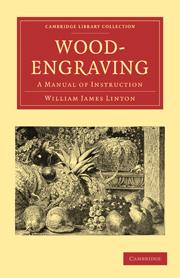Book contents
- Frontmatter
- PREFACE
- Contents
- ILLUSTRATIONS
- CHAPTER I Of engraving in relief
- CHAPTER II Of the history of Wood-Engraving
- CHAPTER III Of the difference between cutting and engraving
- CHAPTER IV Of the tools required for engraving on wood
- CHAPTER V Of drawing on wood for engraving
- CHAPTER VI Of the method of procedure in engraving
- CHAPTER VII Of things to be avoided
- CHAPTER VIII Of things to be aimed at
- CHAPTER IX Of beauty of line
- CHAPTER X Of the use and abuse of photography
- CHAPTER XI Of what constitutes an Artist
- CHAPTER XII of works for reference
- Index
- Plate section
CHAPTER V - Of drawing on wood for engraving
Published online by Cambridge University Press: 29 August 2010
- Frontmatter
- PREFACE
- Contents
- ILLUSTRATIONS
- CHAPTER I Of engraving in relief
- CHAPTER II Of the history of Wood-Engraving
- CHAPTER III Of the difference between cutting and engraving
- CHAPTER IV Of the tools required for engraving on wood
- CHAPTER V Of drawing on wood for engraving
- CHAPTER VI Of the method of procedure in engraving
- CHAPTER VII Of things to be avoided
- CHAPTER VIII Of things to be aimed at
- CHAPTER IX Of beauty of line
- CHAPTER X Of the use and abuse of photography
- CHAPTER XI Of what constitutes an Artist
- CHAPTER XII of works for reference
- Index
- Plate section
Summary
AN engraver of any ability may engrave upon a plain block, a block on which there is no drawing, no indication whatever of what he is about to do. He can engrave (as he can draw) “out of his own head,” improvising his subject; or he may engrave from a picture or copy before him, as is done by the engraver in steel or copper. But he has not the facilities of the copper-engraver, who can draw or trace his most delicate outlines, strengthen, alter, or remove them as needful, and then add the shadows, elaborating more and more as he may find occasion. The wood-engraver can not so alter or remove. Everything is done at once, and what is cut remains. He may indeed cut away more wood, so lightening and sometimes giving tone to certain parts of his subject; he may clear away altogether: but there is the limit of his power of alteration or amendment. It is therefore desirable that there should be some guide for him on the block before he begins to engrave. In all “black-line ” work, such as has been already described, it is absolutely necessary to have every line drawn upon the wood, except perhaps a mere series of shadow lines, which the engraver might be allowed to give at his own discretion, but even then the colour to be obtained by those lines would have to be shown by a tint washed on the block. The fineness or coarseness of these shadow lines, perhaps their direction and character, might be left to the engraver. Not so much as this was left to the early wood-cutters or engravers. Every line was distinctly drawn.
- Type
- Chapter
- Information
- Wood-EngravingA Manual of Instruction, pp. 46 - 51Publisher: Cambridge University PressPrint publication year: 2010First published in: 1884

